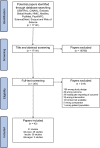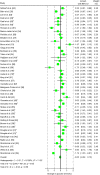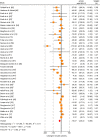The Effect of a Single Bout of Continuous Aerobic Exercise on Glucose, Insulin and Glucagon Concentrations Compared to Resting Conditions in Healthy Adults: A Systematic Review, Meta-Analysis and Meta-Regression
- PMID: 33905087
- PMCID: PMC8363558
- DOI: 10.1007/s40279-021-01473-2
The Effect of a Single Bout of Continuous Aerobic Exercise on Glucose, Insulin and Glucagon Concentrations Compared to Resting Conditions in Healthy Adults: A Systematic Review, Meta-Analysis and Meta-Regression
Abstract
Background: Elevated glucose and insulin levels are major risk factors in the development of cardiometabolic disease. Aerobic exercise is widely recommended to improve glycaemic control, yet its acute effect on glycaemia and glucoregulatory hormones has not been systematically reviewed and analysed in healthy adults.
Objective: To determine the effect of a single bout of continuous aerobic exercise on circulating glucose, insulin, and glucagon concentrations in healthy adults.
Methods: CENTRAL, CINAHL, Embase, Global Health, HMIC, Medline, PubMed, PsycINFO, ScienceDirect, Scopus and Web of Science databases were searched from inception to May 2020. Papers were included if they reported a randomised, crossover study measuring glucose and/or insulin and/or glucagon concentrations before and immediately after a single bout of continuous aerobic exercise (≥ 30 min) compared to a time-matched, resting control arm in healthy adults. The risk of bias and quality of evidence were assessed using the Cochrane Risk of Bias Tool and GRADE approach, respectively. Random-effects meta-analyses were performed for glucose, insulin, and glucagon. Sub-group meta-analyses and meta-regression were performed for categorical (metabolic state [postprandial or fasted], exercise mode [cycle ergometer or treadmill]) and continuous (age, body mass index, % males, maximal aerobic capacity, exercise duration, exercise intensity) covariates, respectively.
Results: 42 papers (51 studies) were considered eligible: glucose (45 studies, 391 participants), insulin (38 studies, 377 participants) and glucagon (5 studies, 47 participants). Acute aerobic exercise had no significant effect on glucose concentrations (mean difference: - 0.05 mmol/L; 95% CI, - 0.22 to 0.13 mmol/L; P = 0.589; I2: 91.08%, large heterogeneity; moderate-quality evidence). Acute aerobic exercise significantly decreased insulin concentrations (mean difference: - 18.07 pmol/L; 95% CI, - 30.47 to - 5.66 pmol/L; P = 0.004; I2: 95.39%, large heterogeneity; moderate-quality evidence) and significantly increased glucagon concentrations (mean difference: 24.60 ng/L; 95% CI, 16.25 to 32.95 ng/L; P < 0.001; I2: 79.36%, large heterogeneity; moderate-quality evidence). Sub-group meta-analyses identified that metabolic state modified glucose and insulin responses, in which aerobic exercise significantly decreased glucose (mean difference: - 0.27 mmol/L; 95% CI, - 0.55 to - 0.00 mmol/L; P = 0.049; I2: 89.72%, large heterogeneity) and insulin (mean difference: - 42.63 pmol/L; 95% CI, - 66.18 to - 19.09 pmol/L; P < 0.001; I2: 81.29%, large heterogeneity) concentrations in the postprandial but not fasted state. Meta-regression revealed that the glucose concentrations were also moderated by exercise duration and maximal aerobic capacity.
Conclusions: Acute aerobic exercise performed in the postprandial state decreases glucose and insulin concentrations in healthy adults. Acute aerobic exercise also increases glucagon concentrations irrespective of metabolic state. Therefore, aerobic exercise undertaken in the postprandial state is an effective strategy to improve acute glycaemic control in healthy adults, supporting the role of aerobic exercise in reducing cardiometabolic disease incidence.
Prospero registration number: CRD42020191345.
© 2021. The Author(s).
Conflict of interest statement
James Frampton, Benjamin Cobbold, Mikhail Nozdrin, Htet Oo, Holly Wilson, Kevin Murphy, Gary Frost and Edward Chambers declare that they have no conflicts of interest relevant to the content of this review.
Figures




Similar articles
-
Accumulated or continuous exercise for glycaemic regulation and control: a systematic review with meta-analysis.BMJ Open Sport Exerc Med. 2018 Dec 17;4(1):e000470. doi: 10.1136/bmjsem-2018-000470. eCollection 2018. BMJ Open Sport Exerc Med. 2018. PMID: 30774976 Free PMC article.
-
The effects of acute bouts of exercise in fasted vs. fed states on glucose and lipid metabolism in healthy adults: A systematic review and meta-analysis of randomized clinical trials.Clin Nutr ESPEN. 2025 Apr;66:320-331. doi: 10.1016/j.clnesp.2025.02.002. Epub 2025 Feb 5. Clin Nutr ESPEN. 2025. PMID: 39921164
-
The Effects of Accumulated Versus Continuous Exercise on Postprandial Glycemia, Insulin, and Triglycerides in Adults with or Without Diabetes: A Systematic Review and Meta-Analysis.Sports Med Open. 2022 Jan 24;8(1):14. doi: 10.1186/s40798-021-00401-y. Sports Med Open. 2022. PMID: 35072806 Free PMC article.
-
Effects of exercise training on metabolic syndrome risk factors in post-menopausal women - A systematic review and meta-analysis of randomised controlled trials.Clin Nutr. 2023 Mar;42(3):337-351. doi: 10.1016/j.clnu.2023.01.008. Epub 2023 Jan 10. Clin Nutr. 2023. PMID: 36736057
-
Multiple short bouts of exercise are better than a single continuous bout for cardiometabolic health: a randomised crossover trial.Eur J Appl Physiol. 2020 Nov;120(11):2361-2369. doi: 10.1007/s00421-020-04461-y. Epub 2020 Aug 9. Eur J Appl Physiol. 2020. PMID: 32776220 Clinical Trial.
Cited by
-
Maintenance of plasma glucose variability after an acute session of aerobic exercise despite changes in insulin and glucagon-like peptide-1 levels in type 2 diabetes.Arch Endocrinol Metab. 2022 May 25;66(3):324-332. doi: 10.20945/2359-3997000000482. Epub 2022 May 25. Arch Endocrinol Metab. 2022. PMID: 35612843 Free PMC article.
-
Effects of aerobic exercise on beta-amyloid, insulin resistance, and blood markers in obese middle-aged women.Phys Act Nutr. 2024 Dec;28(4):42-48. doi: 10.20463/pan.2024.0031. Epub 2024 Dec 31. Phys Act Nutr. 2024. PMID: 39934629 Free PMC article.
-
The acute effect of glucagon on components of energy balance and glucose homoeostasis in adults without diabetes: a systematic review and meta-analysis.Int J Obes (Lond). 2022 Nov;46(11):1948-1959. doi: 10.1038/s41366-022-01223-y. Epub 2022 Sep 19. Int J Obes (Lond). 2022. PMID: 36123404 Free PMC article.
-
Comparative effectiveness of playing golf to Nordic walking and walking on acute physiological effects on cardiometabolic markers in healthy older adults: a randomised cross-over study.BMJ Open Sport Exerc Med. 2023 Jan 4;9(1):e001474. doi: 10.1136/bmjsem-2022-001474. eCollection 2023. BMJ Open Sport Exerc Med. 2023. PMID: 36816424 Free PMC article.
-
Urinary extracellular vesicle as a potential biomarker of exercise-induced fatigue in young adult males.Eur J Appl Physiol. 2022 Oct;122(10):2175-2188. doi: 10.1007/s00421-022-04995-3. Epub 2022 Jul 4. Eur J Appl Physiol. 2022. PMID: 35781843 Free PMC article.
References
Publication types
MeSH terms
Substances
LinkOut - more resources
Full Text Sources
Other Literature Sources
Medical
Research Materials
Miscellaneous

